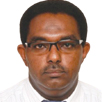
|
Hussein Gadain
Chief Technical Advisor
SWALIM Project, Food and Agriculture Organization of the United Nations
Kenya
Biography
Dr. Hussein Gadain is a Sudanese national with vast working experience that spreads over 25 years of engagement in water and land resources development and management, humanitarian, recovery and development issues. He is currently the Chief Technical Advisor of the Somalia Water and Land Information Management (SWALIM) project of the Food Agricultural Organization of the United Nations a position that he took in February 2013. However, he has been working for FAO Somalia since 2006 when he joined as the Water Coordinator for the SWALIM project. Hussein has overseen numerous remarkable achievements such as developing the hydro-meteorological monitoring networks, river basin management and the irrigation barrage rehabilitation, water sources inventories, strategic studies in water and land resources, and the hydrogeological survey. Previously, Hussein served for five years with the United States Geological Survey (USGS) as Regional Hydrologist for the Horn of Africa (10 countries) under the USAID funded, Famine Early Warning System Networks (FEWS NET). He has led and managed large scale hydro-meteorological hazard activities and their impacts on food security, developed decision support tools and transferred knowledge and technologies to the national hydrological and meteorological service departments in the Horn of Africa. Before joining development projects and programmes in the Horn of Africa, Dr. Gadain was a researcher at the University of Dar es Salaam and the Hydraulic Research Station of the Ministry of Irrigation and Water Resources in Sudan where he started his career as an irrigation research engineer in 1990. Hussein has published and contributed to numerous scientific publications that relate to water and land resources and their sustainable use in developing countries. Hussein holds a B. Sc. Degree in Civil and Hydraulics Engineering from the Sudan University of Science and technology, an M. Sc. and PhD degrees in Water Resources Engineering from the University of Dar es Salaam in Tanzania. His major areas of research are hydrology, water resources management and decision support tools.
Abstract
Somali Natural Resource Monitoring Using Remote Sensing
Following more than 20 years of civil unrest, environmental information for Somalia is scarce while there is clear evidence that the war economy fuelled by the conflict is rapidly depleting the countrys natural resources. In its efforts towards alleviation of poverty, strengthening of livelihoods and food security, FAO has a lead role in the collecting, analyzing and disseminating high quality up to date information on food security, nutrition and natural resources. However, due to insecurity and accessibility difficulties, these dearly needed information has mainly been based on oral tradition, assumptions, rough estimates and historical data. Remote Sensing (RS) and GIS techniques can be applied to effectively measure and manage natural resources. Towards this effort, FAO-SWALIM has recently collected and analyzed RS data and derivatives on land use/land cover (LULC), hydrogeology and tree cutting for charcoal production.
Medium resolution (ASTER) satellite images were interpreted to produce maps on LULC Somalia. The FAO software, MADCAT, was used in the interpretation of 500 m spacing dot samples superimposed on the satellite images. High Resolution satellite images (GeoEye and World View) were imported in MADCAT and used to improve the interpretation.
Groundwater provides a main source of water for humans, agriculture and livestock. FAO-SWALIM understand that knowledge of groundwater resources is essential for strategic long-term planning necessitating a Hydrogeological Survey and Assessment of Selected Areas in Somaliland and Puntland (HASP) to create a base for a more efficient and sustainable groundwater use and exploration. RS was applied in the HASP process through the analysis of multispectral satellite images. RS study was conducted to obtain the land surface parameters and more accurate information on the geological conditions, existing geo-morphological forms and fractures pattern. The information interpreted in relation to the characteristics of rocks and their differences, mineralogical and geological composition of the studied areas provided vital information used in producing HASPs Regional Hydrogeological Map of Somaliland and Puntland adapted to the scale 1:750 000.
Very High Resolution (VHR) satellite imagery (GeoEye) of 2011 and 2013 have been used in developing a semi-automatic mapping method of charcoal production sites as a proxy of tree loss over a 6,000 sq km area along the Juba River in Southern Somalia. Wood charcoal production is one of the most relevant businesses supporting war regimes which have ruled in Southern Somalia from 2006 to 2012. The analysis of the changes between the two dates gave an average tree loss of 3.3%, corresponding to 520,520 trees. The results help to better understand the dimension and impact of charcoal production in Southern Somalia and are a first step towards the development of a charcoal production monitoring system.
|

